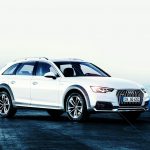
From 348 GT Competizione to 488 Pista, we compare five generations of Ferrari’s track-inspired ‘special series’ V8s on the roads of North Wales. Which is the most special of all? Photography Aston Parrott. Words John Barker.
SPECIAL FORCES Ferrari’s V8 road racers from 348 GTC to 488 Pista – we drive them all.
COVER STORY ROAD RACERS
348 GT Competizione Type F119, 360 Challenge Stradale Type F131, 430 Scuderia Type F131, 458 Speciale Type F142 and 488 Pista Type F142M – John Barker tries to choose a favourite
Top of the list of things I don’t want to hear at 4.15am is my alarm clock. Today, a very close second is the heavy patter of raindrops. That was emphatically not in the forecast. Judging from the demeanour of our guest house owner, I’m guessing that a new entry at the top of her own personal list is the high-idle drone of five flat-plane-crank V8s warming up at 5am. Still, one person’s cacophony is another’s amazing, laugh-out-loud, close-harmony quintet.
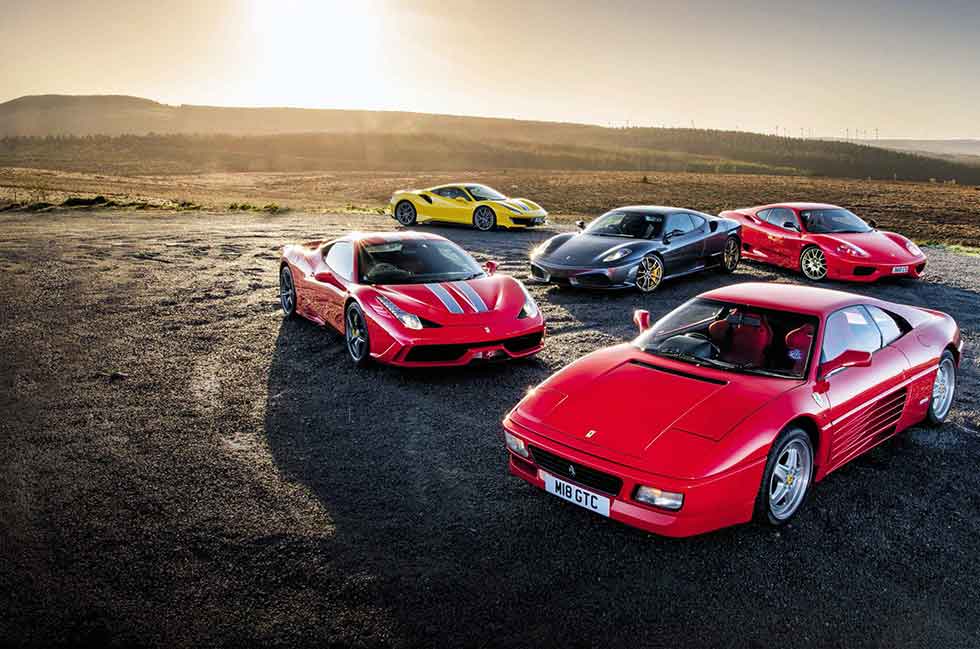
A gentle, warming trundle through the sleeping town pops us out onto the smooth, glistening sweep of the bypass. In the darkness, I’m tracking the glow of four pairs of round tail-lights, a feature that has been a constant of the mid-engined V8 model line. With the exception of the car I’m driving: a 348. This, though, is no regular 348, because this is no gathering of regular V8 Ferraris.
‘THE SPECIALE HAS AN EFFORTLESS POISE THAT’S AT ODDS WITH THE ENGINE’S MANIC EBB AND FLOW’
Yowling along ahead are Ferrari’s feistiest and most focused series-production V8s: the 360 Challenge Stradale, 430 Scuderia, 458 Speciale and 488 Pista. And making up this full house of Maranello’s ‘special series’ V8s is the car I’m driving, the rarest of them all; the 348 GT Competizione. Just 50 were built and this is one of only eight right-hand-drive examples.
It was especially disappointing to hear rain when we woke because we’ve dragged ourselves out of bed for a sunrise shot. There’s a magical time around sunrise and sunset – ‘the golden hour’ – when the light is low and soft, and car shapes look glorious. Over dinner, photographer Aston Parrott had floated the idea of a sunrise shot, explaining that the location was an hour away, which would mean a 4am start, yet without a moment’s pause every one of our owners agreed.
So here we are, heading towards Denbigh, North Wales, on shiny black, empty roads. At least it has stopped raining. There are even tantalising glimmers of brightness in the dark sky, but as we drive further and climb higher, the temperature drops. Soon there’s snow on the hills all around us, bright in the headlamps. Happily, dropping down the other side, the snow vanishes and, almost miraculously, within a mile of the location the clouds break and – ta-da! – we get a sunrise. Relief all round.
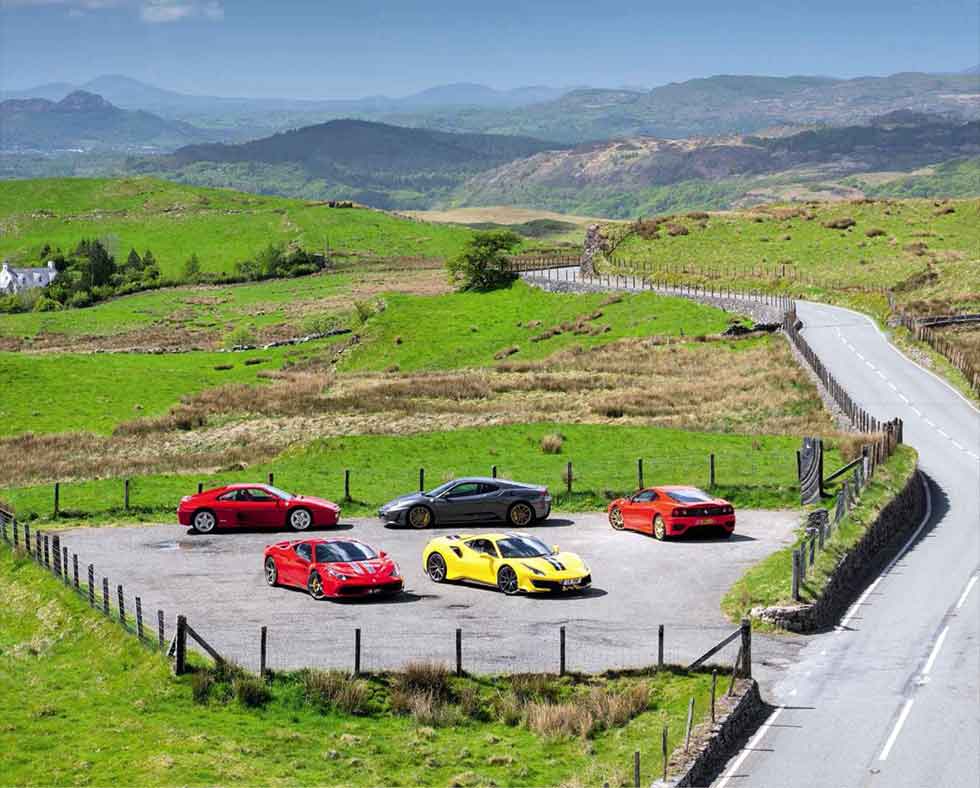
I confess: the 348 GT Competizione wasn’t a car I’d been hankering to drive. How foolish of me. Yesterday afternoon I drove it across to the coast and it was an utter delight. The GTC isn’t like other 348s; it doesn’t feel – and especially doesn’t handle – like other 348s.
There were moments when the road dipped and swerved invitingly and the GTC met the challenge with poise to spare.
‘I CONFESS: THE 348 GT COMPETIZIONE WASN’T A CAR I’D BEEN HANKERING TO DRIVE. HOW FOOLISH OF ME’
As its name suggests, there are links with competition models, in this case Ferrari’s one-make Challenge racers.
The fifty road-going Competiziones were built in 1993, late in the 348’s life, when ‘tb’ had become the better handling ‘GTB’. Even later, Michelotto, Ferrari’s long-standing, outsourced racing department, built a couple of full-on race 348s. Dubbed GT / C LMs, one finished a creditable 11th overall at Le Mans in 1994, marking the first finish for a Ferrari at the 24-hour classic since 1982.
‘IS IT POSSIBLE TO PICK JUST ONE FROM THIS FIVE? IN MANY RESPECTS THE CHALLENGE STRADALE IS THE HIGH POINT’
I’d never seen a GTC in the metal before collecting Paul Hogarth’s immaculate example. It’s got a more purposeful stance than the standard model thanks to the split-rim Speedlines, which are wider and an inch bigger in diameter.
They wear plump Pirelli P Zeros and fill the arches so much better. Swing open the lightweight door, which is skinned in carbon-Kevlar, and you can see sill finishers in the same material and carbon-shelled F40 bucket seats, too. More carbon-Kevalr is used for the front and rear bumpers and contributes to a claimed weight-saving of almost 200kg, for a dry weight of 1180kg. This seems rather optimistic and when this car was popped on the scales with half a tank of fuel, it came in at close to 1380kg. Still, there’s more to it than weight reduction, and, as we’ve already discovered, the GTC drives beautifully.
Slot yourself into the driver’s bucket and, if you’ve ever sat in a 348, your surroundings will be very familiar; all the regular fixtures and fittings are present, including carpets, door casings and Veglia dials, though there’s a bespoke steering wheel centre finisher, here inscribed ’38/50′.
Compared with the others it’s a small car, a feeling enhanced by the low scuttle and a slightly raised driving position giving a mild sensation of sitting ‘on’ the car.
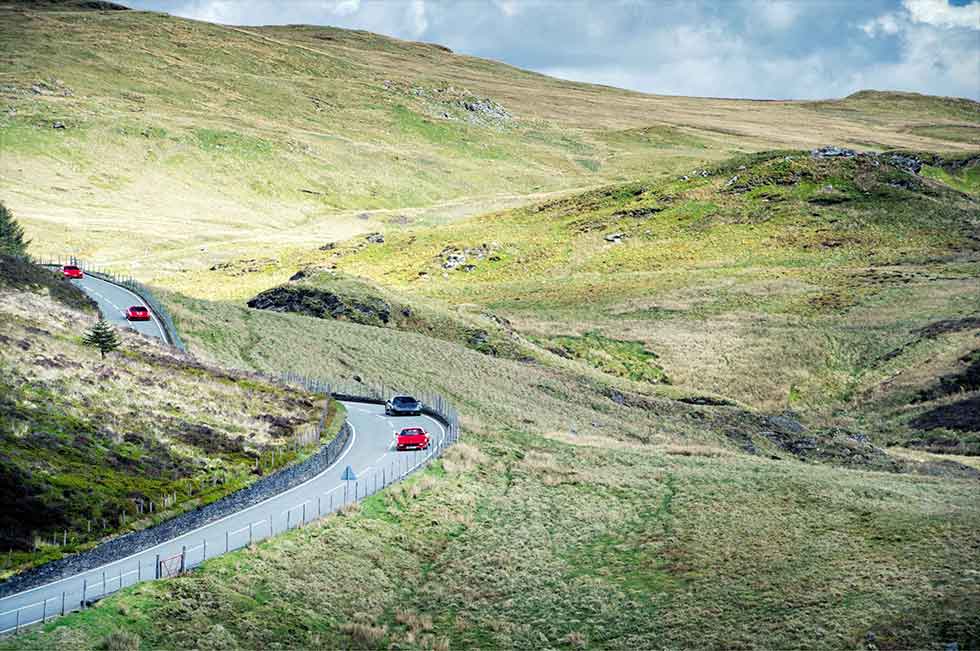
Plug the USB-like immobiliser tag into the steering column, hear the beep, twist the key and from over your shoulder comes that familiar, smooth, plain engine note. The GTC’s 3.4-litre V8 doesn’t claim any increase in power, just the stock 320bhp, and although it has a different exhaust initially it doesn’t sound very different from stock either.
Engagement is guaranteed, though, because spouting from the open gate on the centre console is a tall gearlever topped with a shiny chrome ball.
‘THE GTC ISN’T LIKE OTHER 348s. IT DOESN’T FEEL – AND ESPECIALLY DOESN’T HANDLE – LIKE OTHER 348s’
The GTC is the only manual car here and, being pre-F355, is somewhat resistant to selecting second gear from cold. Adding to the challenge, initial throttle travel is rather sticky and the pedals are offset to the left. Right away, though, the way the GTC drives impresses; the ride is smooth and calm, though the sharp retort over cats’ eyes suggests it’s underpinned by some firm control.
With everything thoroughly warmed, the engine proves to be an absolute gem; it spins up so sweetly and so eagerly, and the delivery and note build to a proper, zingy, rewarding top-end. Shorter gearing certainly helps and the gearshift is snappy and satisfying, but unquestionably the stand-out feature of this 348 is its dynamics. It seems never to put a wheel wrong, even at a good pace across challenging roads. Crucially, there’s absolutely no suggestion that the back end is going to be an issue.
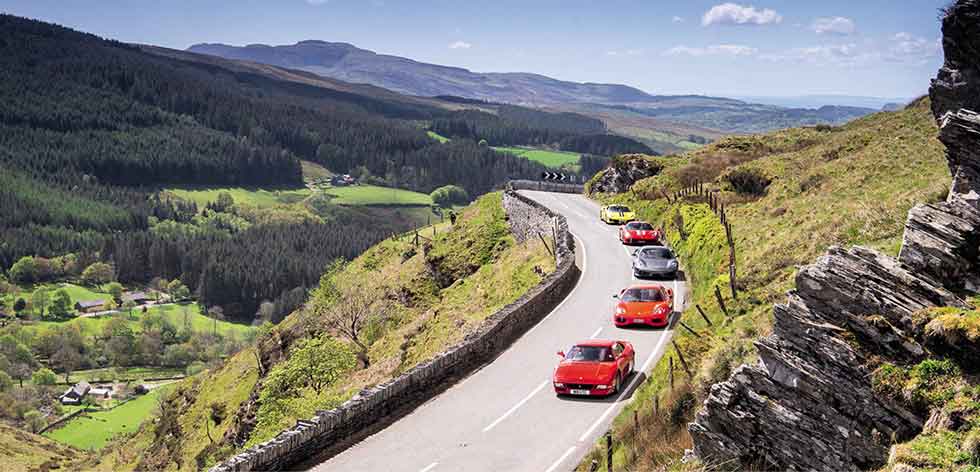
The unassisted steering is full of feedback and chatter and, although it becomes rather vague around the centre at speed, the GTC is always wonderfully accurate once guided into curves and corners. Grip is strong but it’s the damping that’s really special, managing to be relaxed for comfort but catching the car effortlessly through tricky sequences for seemingly undefeatable composure; you rarely feel the mid- engined mass. The GTC is not just the best 348 I’ve driven, I reckon it’s one of the best mid-engined cars of its era.
The step to the 360 Challenge Stradale is a big one for a few reasons, the first being that there was no stripped-down, toned-up version of the F355 that separates them. The second is that in 1999 Ferrari completely reinvented the V8 model line with the 360 Modena, adopting aluminium monocoque construction and allowing the wind tunnel to dictate the proportions more than ever before.
‘IT LOOKS AS THOUGH IT HAS ROLLED OUT THE BACK OF A TRANSPORTER READY FOR A SILVERSTONE TEST SESSION’
There were race versions of the 360 before the Challenge Stradale came along in 2003 and, although it appeared to use race-car parts, particularly the carbon trim, it was in fact merely inspired by them. The Stradale was a bespoke, thoroughly engineered, dedicated road racer. I was lucky enough to be on the launch but have somehow managed not to drive one since. Slipping into the driving seat of John Hanlon’s cherished example is a reminder of just how special it is, how much effort Ferrari invested in it.
In effect, Ferrari blueprinted the 360 Modena’s 3.6-litre evolution of the F355’s five-valve-per-cylinder V8, lifting it from 400 to 420bhp, which didn’t look overly generous given the near-£30k premium but, as I discovered back then, there’s a lot more to the CS than that. The sole gearbox was a faster-shifting version of the single-clutch ‘F1’ automated manual, while braking was by carbon discs – both ‘box and brakes expensive options on the Modena. Meanwhile the interior was an exquisite confection of glossy carbonfibre, painted aluminium and Alcantara. The lack of soft furnishings gave a proper race-car feel and, in total, Ferrari claimed to have trimmed 110kg off the 360’s kerbweight (for the same 1180kg dry weight as the 348). Their efforts helped lop a massive 3.5sec off the 360’s Fiorano lap time.
‘THE GTC’S UNASSISTED STEERING IS FULL OF FEEDBACK AND CHATTER’
Most of the launch cars came with the factory stripe, a beautifully executed but eye-wateringly expensive option (£3100 in the UK) that about a quarter of customers took up. Many more fitted their own for considerably less but Hanlon hasn’t, which is why his car looks as though it has rolled out the back of a transporter ready for a Silverstone test session. That and the way the gold-painted alloys are tucked up into the arches, though it’s running standard CS ride height.
The Modena drove superbly but looked rather delicate on its slim front tyres. The Stradale sorts that out. Along with a lower ride height, wider tyres and gorgeous, web-like alloys, its more sculpted front scoops look hungrier, and if you take a knee at the rear, you can see the twin venturis bridged by the rear suspension arms. Proper stuff.
Drop into the Stradale and you find that its beautiful, leather-trimmed seat feels even better than it looks. The bucket is so comfortable, so cupping and laid-back that it feels as though it has been moulded just for you, as does the steering wheel’s chunky, sculpted rim. Through the vaguely quartic wheel you can see a large, central tachometer, yellow-faced and red-lined at 8500rpm but with numbers all the way up to 10, while in the rear-view mirror you can see the engine’s carbon air-boxes, glossy in the light of the windowed engine bay.
‘7000RPM ITS NOTE MUTATES AND BECOMES EVEN MORE URGENT AS IT SURGES FOR THE RED LINE’
Hit the big red start button (after you’ve stuck the key in the column and turned it) and the Stradale’s V8 bursts into life. It has a deeper, more hollow bass tone than the 348’s, overlaid with a busy, lighter top note, and it sends tremors through the floor and seat. Give the throttle a decent squeeze and it sounds as though the V8 is in the cockpit with you. It thrives on revs, getting ever stronger as the needle climbs the dial, until you’re properly howling along. Even in this company it feels excitingly quick, though time has caught up with – and overtaken – the F1 gearbox. Personally, I enjoy the challenge of getting the best out of it. It’s great on downshifts but you need to be positive with the throttle when manoeuvring to stop it dithering and give a mechanically sympathetic lift on upshifts to achieve the level of finesse we take for granted with current DCTs.
You have to be mindful of the low nose on bumpy B-roads, too, but otherwise the Stradale’s dynamics deliver in spades. It’s firmly damped without being harsh and stays remarkably flat tacking into the corners where, right from the off, you sense that there will be huge grip from the Pirelli P Zero Corsas. Initially, what’s most surprising after the 458 or 488 – or any recent Ferrari for that matter – is how relaxed the steering is, how slow the initial response. It’s a characteristic you adapt to quickly, within just a few miles, because everything else falls deliciously into place.
Up the pace, commit to a corner, the nose locks onto the desired line and the Stradale settles deliciously into the apex. It’s a great feeling, and there’s such detailed feedback about the grip at either end that you know there’s more to be had, that it will be with you over the limit. Not today and not on this road. Lapping Fiorano all those years ago showed that the CS’s composure and control extend beyond the limit of grip, that it slips into power oversteer and back again cleanly, confidently, playfully. The only distraction is the howl of the V8: wrung out, the volume of noise filling the cockpit is so great it feels as though it’s about to burst it at the seams.
How do you follow that? Well, as the last of the 1288 Stradales was being built, Ferrari was launching the 360 Modena’s replacement, complete with all-new and much more powerful 32-valve V8. Out of the box, the new F430’s 4.3-litre engine delivered 483bhp, ensuring that the next special series model would be a whole lot more powerful.
The F430 was based on the 360 but incorporated much new technology, developed with input from Michael Schumacher among others. It was the first Ferrari fitted with the manettino, allowing access to a number of pre-set dynamic characters tailored to different driving scenarios. A key element in the delivery of this was another Ferrari first, the E-Diff or electronic limited-slip differential. This could be finely manipulated electronically and, in conjunction with other adjustable features such as damping, throttle and gearbox response and traction/stability control, used to promote or enhance certain dynamic behaviours.
The Scuderia was launched in 2007 with 503bhp. That’s a big number but a gain over stock of only 20bhp, which in percentage terms is a more modest uplift than the Stradale’s. Still, along with a claimed weight-saving of 100kg, this guaranteed blistering acceleration. Around Fiorano, the Scuderia also matched the Enzo’s 1min 25sec lap time, by braking later and accelerating faster out of the turns, E-Diff and traction control working together to find optimum drive. All the driver had to do was pin the throttle. Ferrari’s F1 test driver, Marc Gene, reckoned a decent driver would get within a second of his best in just a few laps.
The Scuderia sounds like a car that takes away all the skill, all the engagement, that goes fast no matter who’s behind the wheel. To assume that would be to do Schumacher, Gene and Ferrari’s engineers a huge disservice because, although there’s all this amazing on-limit ability available, you don’t need to drive the Scuderia hard to enjoy and appreciate it. Indeed, evidence of its dynamic bandwidth is there on the steering wheel: the ‘bumpy road’ button. The Scuderia was the first Ferrari to have the separate damper switch, at Schumacher’s insistence.
Settling into Ian Humphris’ superb example, it’s somehow not as racer-raw as the Stradale despite having even more polished carbonfibre and exposed aluminium. Maybe it’s because the facia – the whole interior, in fact – is a busier, more obviously fashioned fusion of shapes and materials. The Scud’s seats are just as well-shaped as the Stradale’s though, even if the ‘3D’ fabric of the centre panels looks like the ‘technical’, breathable fabric you find on trainers.
Twist the key, push the button and – boom!– the V8 lights up. The seat and floor zizz as they did in the Stradale but the new-generation ‘F136’ V8 has a smoother, tighter sound. It still blares like you’re too close to the speakers at a concert but this time the volume matches the throttle demand, so when you want you can make relatively stealthy progress.
‘THE PISTA IS TRUE TO THE SPECIAL-SERIES VALUES. IT HAS THE SAME INTIMATE RELATIONSHIP WITH THE ROAD’
There’s a simmering energy suffusing the Scuderia though, a pent-up urge to cut loose. It’s there in the ease with which the V8 revs and the keenness of the gearbox to shuffle down the gears. Ferrari really nailed the automated, single-plate manual gearbox with the Scuderia. Dubbed F1 SuperFast2, at its swiftest this final iteration of the automated manual could change gear in just 60 milliseconds. But it’s not just the shift speed that impresses. Its finesse is good, too, its speed matched to throttle demand. Sure, the fastest upshifts still jolt but most of the time the ‘box does exactly what you expect and doesn’t draw attention to itself.
The same is true of the Scuderia’s dynamics. There’s an awful lot the electronics can do to enhance its behaviour but most of the time they’re not intervening because at its core the Scuderia is a beautifully sorted driver’s car. Its steering is feelsome and more instantly responsive than the Stradale’s, and while it’s still not super-sharp, it’s direct enough for me. In terms of ride, it’s taut but you do have bumpy road mode to add suppleness, while in overall feel the impression is that it’s a slightly narrower car than the Stradale, though this doesn’t seem to affect its cornering ability to any degree. There’s the same sensation of endless grip at a decent pace, and when you let the engine have its head, the pace is shockingly fast but the chassis easily meets the challenge.
On a dry, warm road the Scuderia’s poise, precision and control are astonishing. It might be pushing 12 years old now but there’s absolutely nothing old-fashioned about the way it tackles a ‘technical’ stretch of asphalt. And does so without any obvious electronic interventions. It simply feels very positive, perfectly balanced and very effective, with terrific grip and corner exit traction. Best of all, you feel that you’re at the heart of it, calling the shots. It’s sensational.
Makes you wonder why you’d need anything more. Then again, if Ferrari offered to build you a naturally aspirated, near-600bhp V8 that made peak power at 9000rpm, you’d be interested, wouldn’t you? And you’d be right to be, because it was extraordinary in 2013 and we now know that it’s unlikely there will ever be anything quite like it again.
The 458 Italia had already ramped things up, introducing a 4.5-litre, direct injection evolution of the F430 engine that hiked power to a remarkable 562bhp. The Speciale took things even further with a host of refinements, including raising the compression ratio from 12.5 to 14:1, changing the cam profiles and redesigning the piston tops and the intake system (saving 8kg in the process). Peak power went up 45 points to an astonishing 597bhp, giving this V8 the highest specific output – 133bhp per litre – of any naturally aspirated production engine.
‘YOWLING ALONG AHEAD ARE FERRARI’S FEISTIEST AND MOST FOCUSED SERIES-PRODUCTION V8s’
It’s an incredible powerplant. As with the Porsche GT3 RS’s flat-six, which also revs to 9000rpm, there comes a thrilling part when the revs get to 7000rpm. Most engines hit the buffers but the Speciale’s V8 kicks on, its note mutating and becoming even more urgent as it surges for the red line. It’s a crazy, spine-tingling experience. Addictive, too, especially as the 458 swapped the automated manual for the heavier but incredibly slick F1 DCT dual-clutch transmission, which gives almost seamless upshifts, even at 9000rpm.
The 458 built on the F430’s electronic architecture, too, increasing the amount of technology to further refine the behaviour of the car generally but especially in extreme situations. So there are magnetorheological dampers, combined (faster) control of the E-Diff and traction control and a new feature called SSC – side slip control – which helps keep a slide in balance if you’re bold enough to twist the manettino round to ‘Race’ or ‘CT Off’.
At first you think that you’d never do that on the road. The steering rate of the 458 was ramped up by about a third compared to the F430 and you might imagine this directness and the engine’s incredible power and appetite for revs would leave you frazzled after a few fast miles. But you quickly adapt your steering inputs and realise that this incredible, naturally aspirated engine can be finely controlled by your right foot.
The last time I was lucky enough to drive Mike Woods’ Speciale, it rained for two days. It was on the Michelin Cup 2s specially developed for fantastic single-lap performance and long-run consistency, too. It seemed that soaking Welsh B-roads were also a consideration because the Speciale was astonishing over the puddled surface, cattle grids and all. I turned all the aids off and revelled in its control. I’m doing the same today, in the dry, and the way it settles into the corners, the tactility of the steering and the feedback and feel as you energise the rear tyres – precisely – with a squeeze of throttle ahead of the apex is absolutely glorious.
‘IN THE RIGHT CONDITIONS. THE PISTA CAN COVER GROUND AT A STAGGERING PACE – AND ENGAGE YOU IN THE PROCESS’
In my experience, passengers don’t cope well with it, feeling the escalating shove in the back, or the lateral g building, hearing the frantic, slightly hysterical howl of the engine and thus fearing that oblivion is but an ill-judged throttle squeeze or flick of steering away. Yet from the driver’s seat the Speciale feels unshakably composed, with an effortless poise that’s at odds with engine’s manic ebb and flow as the road alternately tightens and opens up. It is slightly surreal, feeling so calm as you wring out a 600bhp V8 to 9000rpm. At one point I caught myself musing what it would be like with a little more mid-range torque…
The answer to that is provided, partly, by the 488 Pista. Partly, because the adoption of twin turbos for the 488’s new 3.9-litre V8 doesn’t bring a little more mid-range torque, it brings a truckload. The Speciale’s peak is a gnat’s short of 400lb ft at 6000rpm; the Pista delivers 568lb ft at 3000rpm – that’s getting on for 50 per cent more at half the revs.
You’d think that this would fundamentally change the way the Pista drives, compared with its predecessors, but it doesn’t. I’ve been lucky enough to drive the Pista a few times now and I’ve grown to like it more each time. It’s true to the special-series values, not only by being 100kg lighter than the stock 488 GTB but by having that same intimate relationship with the road. The damping of the Pista is fabulous, the whole car settling into an apex four-square, massive grip from the warm Cup 2s holding the exact line.
You’d expect the readily available torque to make things different on the exit, and it can, if you want it to, but for a turbocharged machine the Pista has great throttle response. You can mete out the torque so that the exit is smooth and orderly, or you can twist the manettino, light up the rear tyres and apply a twist of opposite lock. All the aids are there, even further refined to cope with the torque uplift, so help is at hand, though sometimes perhaps not quite as readily as you might expect.
‘GIVE THE THROTTLE A DECENT SQUEEZE AND IT SOUNDS AS THOUGH THE V8 IS IN THE COCKPIT WITH YOU’
It’s a phenomenally fast car, the Pista, and it delivers peak power, all 710bhp of it, at 8000rpm. There are some things missing, though, particularly after the Speciale, the first being a thrilling engine note. After a promising, bassy start-up and idle, the sound seems to get lost in the plumbing for the two turbochargers. The second is throttle response. The Pista’s is very good but, after the vernier precision of the Speciale and Scuderia, you notice the momentary pause before you get what you asked for.
A third reservation is also connected to throttle response, though in the wider sense. As we’ve mentioned, despite its fair-weather Michelin Pilot Sport Cup 2s, the Speciale is unexpectedly, staggeringly driveable in poor conditions. So, too, is the stock 488 GTB, which has the same amount of torque as the Pista but is shod with ‘regular’ Michelins or Pirellis. But you have to tread carefully in the Pista on a wet road, or even when the Cup 2s are just cold, because a decent, thoughtless stab of throttle will momentarily unstick the rear tyres, even with traction control on.
In the right conditions, though, the Pista can cover the ground at a staggering pace – and engage and immerse you in the process, challenging and rewarding like any of these super series cars. It takes a little longer to build up the confidence, to get the measure of how it will respond, but it’s a mighty buzz when you’re riding the throttle with a twist of opposite lock and still moving forwards at a rate. It’s pretty much how a modern-day F40 would feel.
‘THERE’S A SIMMERIG ENERGY SUFFUSING THE 430 SCUDERIA, A PENT-UP URGE TO CUT LOOSE’
Is it possible to pick just one from this five? Probably not. In many respects the Challenge Stradale is the high point. With the barest trim and sportiest options that were offered – aluminium roll hoop, fabric seat covers, harness belts, sliding Lexan side windows – it really does look and feel like a road-going race car. None of the others here evoke that in quite the same way. It lives up to its name.
The Speciale does, too, not least by having the ultimate Ferrari naturally aspirated V8. Awesome is a rather over-used word, but it’s an apt description of the sound and fury of this engine revving flat-out to 9000rpm. Yet it’s a very easy supercar to exploit, being perfectly well mannered and having a sublime chassis. An amazingly useable car, already worthy of legendary status.
The 348 Competizione has little more than half its power but what a sweet surprise it has been. Unassisted steering, a manual gearshift, no electronics for stability or traction… it is tactile and capable and puts a smile on your face with its ability to flow over difficult roads, poised and precise. Underrated and overlooked. A 348 like no other.
The fact that the Pista – a 710bhp, twin-turbo, mid-engined, rear-wheel-drive supercar – can be driven with all aids off, dancing on the limit of grip, shows that Ferrari consistently nails the basics. Yet its throttle response and delivery make it a different sort of special series car.
For me, the Scuderia is the absolute sweet spot. It’s not as futuristic-looking as the 458 or 488 and its gearbox isn’t as slick, but it doesn’t feel like an old car; there’s no need to make any excuses for it. It is ferociously fast – as fast as you’ll ever need – and dynamically it’s as engaging and rewarding as any of the other cars here, too. It also happens to be undervalued. Not for long, I confidently predict.
With thanks to Paul Hogarth, John Hanlon, Ian Humphris and Mike Woods for allowing us to enjoy their wonderful cars, and also to Russell Smith at Bob Houghton Ltd.
Ferrari 348 GT Competizione Type F119
ENGINE V8, 3404cc
MAX POWER 320bhp @ 7200rpm
MAX TORQUE 239lb ft @ 5000rpm
TRANSMISSION Five-speed manual, rear-wheel drive, limited-slip differential
SUSPENSION Front and rear: double wishbones, coil springs, telescopic dampers, anti-roll bar
STEERING Rack and pinion, unassisted
BRAKES Vented discs, 300mm front, 305mm rear, ABS
WHEELS 8 x 18in front, 10 x 18in rear
TYRES 225/40 ZR18 front, 265/40 ZR18 rear
WEIGHT 1180kg (dry)
POWER TO WEIGHT 275bhp/ton (dry weight)
0-62MPH 5.0sec (est)
TOP SPEED 175mph (est)
PRICE WHEN NEW £84,875
VALUES TODAY £150,000-plus
Above and left: Regular 348s, even the later, improved versions, tended to make fast progress on tricky roads a heart-in-mouth challenge; GTC’s superb chassis keeps its masses in check quite brilliantly. Above and right: Competizione was limited edition (just 50 built) inspired by the Challenge one-make race series of the day; steering wheel badge reveals this was no.38. Split-rim Speedline alloys are very much of their time but fill the 348’s arches beautifully.
Ferrari 360 Challenge Stradale Type F131
ENGINE V8, 3586cc
MAX POWER 420bhp @ 8500rpm
MAX TORQUE 275lb ft @ 4750rpm
TRANSMISSION Six-speed automated manual, rear-wheel drive, limited-slip differential
SUSPENSION Front and rear: double wishbones, coil springs, adaptive dampers, anti-roll bar
STEERING Rack-and-pinion, hydraulically assisted
BRAKES Vented carbon-ceramic discs, 380mm front, 350mm rear, ABS
WHEELS 9 x 19in front, 13 x 19in rear
TYRES 225/35 ZR19 front, 285/35 ZR19 rear
WEIGHT 1280kg
POWER TO WEIGHT 333bhp/ton
0-62MPH 4.1sec (claimed)
TOP SPEED 186mph (claimed)
PRICE NEW £133,025
Above and left: Freer-flowing intake and exhaust systems helped liberate an extra 20bhp from the 360’s 3.6-litre V8, lifting peak power to 420bhp and expanding its vocal range to thrilling effect. Shapely seats (far left) feel moulded to your body. Above and right: Lowered ride height and wide alloys tucked up into the arches gave the Stradale so much more presence than the standard 360. Interior, too, was transformed; for Barker this is the first time he’s driven a CS since the launch in 2003.
Ferrari 430 Scuderia Type F131
ENGINE V8, 4308cc, 32 valves
MAX POWER 503bhp @ 8500rpm
MAX TORQUE 347lb ft @ 5250rpm
TRANSMISSION Six-speed automated manual, rear-wheel drive, E-diff, F1-Trac
SUSPENSION Front and rear: double wishbones, coil springs, adaptive dampers, anti-roll bar
STEERING Rack-and-pinion, hydraulically assisted
BRAKES Vented carbon-ceramic discs, 398mm front, 351mm rear, ABS, EBD
WHEELS 7.5 x 19in front, 10 x 19in rear
TYRES 235/35 ZR19 front, 285/35 ZR19 rear
WEIGHT 1350kg
POWER TO WEIGHT 378bhp/ton
0-62MPH 3.6sec
TOP SPEED 198mph (claimed)
PRICE NEW £172,605
VALUE TODAY £130,000-£200,000
Above and right: Scuderia interior busier and more technical in feel than the earlier cars’; new features included steering wheel-mounted manettino to switch between driving modes, and the ‘bumpy road’ button to give a pliant ride while still accessing full dynamic performance. Above and left: Scuderia looked superficially similar to the 360 Stradale, but underneath there was a completely new engine, good for an extremely potent 503bhp, and a raft of new chasis tech, too, including E-Diff.
Ferrari 458 Speciale Type F142
ENGINE V8, 4497cc
MAX POWER 597bhp @ 9000rpm
MAX TORQUE 398lb ft @ 6000rpm
TRANSMISSION Seven-speed dual-clutch transmission, rear-wheel drive, E-diff, SSC
SUSPENSION Front: double wishbones, coil springs, adaptive dampers, anti-roll bar. Rear: multi-link, coil springs, adaptive dampers, anti-roll bar
STEERING Rack-and-pinion, hydraulically assisted
BRAKES Carbon-ceramic discs, 398mm front, 360mm rear, ABS, EBD
WHEELS 9 x 20in front, 11 x 20in rear
TYRES 245/35 ZR20 front, 305/30 ZR20 rear
WEIGHT 1395kg
POWER TO WEIGHT 435bhp/ton
0-62MPH 3.0sec (claimed)
TOP SPEED 202mph (claimed)
PRICE NEW £208,000
VALUES TODAY £240,000-£350,000
Above and right: 458 Italia had raised the intensity of the mid-engined V8 genre with its super-high-rewing V8, double-clutch gearbox and hyper-alert steering, and Speciale took it all up another notch. Above and right: Seeing red… few road car engines in the entire history of the automobile have revved to such intoxicating effect as the Speciale’s naturally aspirated 4.5-litre 597bhp V8.
Ferrari 488 Pista Type F142M
ENGINE V8, 3902cc, twin-turbo
MAX POWER 710bhp @ 8000rpm
MAX TORQUE 568lb ft @ 3000rpm
TRANSMISSION Seven-speed DCT, rear-wheel drive, E-Diff3, F1-trac, SSC
SUSPENSION Front: double wishbones, coil springs, adaptive dampers, anti-roll bar. Rear: multi-link, coil springs, adaptive dampers, anti-roll bar
STEERING Rack and pinion, hydraulically assisted
BRAKES Carbon-ceramic discs, 398mm front, 360mm rear, ABS
WHEELS 9 x 20in front, 11 x 20in rear
TYRES 245/35 ZR20 front, 305/30 ZR20 rear
WEIGHT 1385kg (with optional lightweight features)
POWER TO WEIGHT 521bhp/ton
0-62MPH 2.85sec (claimed)
TOP SPEED 211 mph (claimed)
PRICE NEW £252,765
VALUE NOW £350,000-plus
Above and right: Pista’s cabin is the most civilised, its seats the most comfortable, but a squeeze of the throttle reminds you there are 710 turbocharged horses waiting to be unleashed. Ah, but can it can match the thrill of the naturally aspirated Speciale? Above and left: Carbonfibre-shelled seats and harnesses reinforce the road-racer vibe in the Pista. Its chassis is the most sophisticated yet, but even with the electronic aids switched off you can still exploit its inherent balance.

